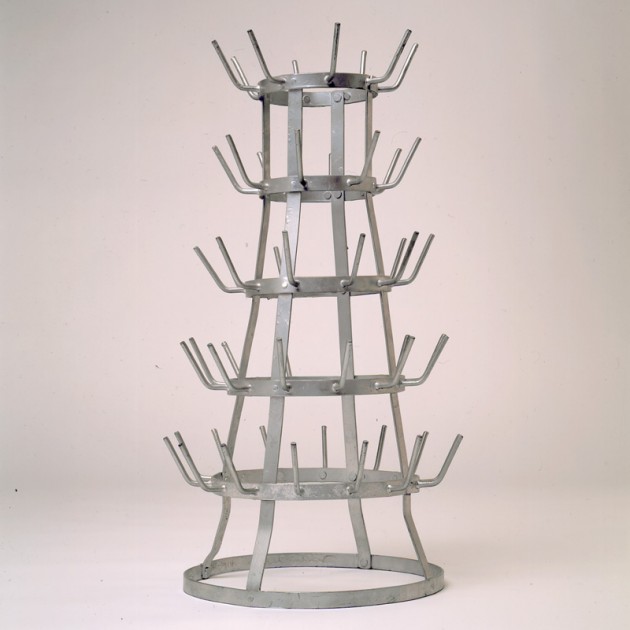For many of the 20th century’s greatest practitioners, the work of a singular artist exercised a potent influence—that artist is Marcel Duchamp (1887–1968). Duchamp to Pop draws from the Norton Simon Museum’s collection and rich archives of two seminal exhibitions in the early 1960s to illustrate Duchamp’s sway over Pop Art and its artists, especially Andy Warhol, Jim Dine and others.
In 1916, Duchamp wrote to his sister with regard to the Bottlerack, “I purchased this as a sculpture already made.” From this description, Duchamp in effect redefined what constitutes a work of art, and thus, the readymade was born.
The original Bottlerack was an unassisted readymade, meaning that it was not altered physically by the artist. The bottle rack was a functional object manufactured for (as its name implies) the drying of glass bottles. Duchamp purchased it from a department store in Paris in 1914 and brought the bottle rack into the art world to alter its meaning. The act of choosing a readymade allowed Duchamp to, as he said in a 1953 interview, “reduce the idea of aesthetic consideration to the choice of the mind, not to the ability or cleverness of the hand.” Thus, Duchamp privileged the artist’s concept and intent over the details of form. SHOW MORE
In 1963, at the prompting of Pasadena Art Museum director Thomas Leavitt, curator Walter Hopps embarked on what was to become Duchamp’s first major museum retrospective. A self-described “Duchamp addict,” Hopps had first met the artist in 1949 through Los Angeles art collectors Walter and Louise Arensberg. After establishing the Ferus Gallery and promoting the local avant garde, Hopps arrived at the Pasadena Art Museum well prepared to tackle this ambitious paean to Duchamp, one that would necessitate loans from private collections and art institutions, as well as the re-fabrication of several lost works.
Duchamp’s persistence and intellectual approach, his definition of the everyday object as art and his sense of wit and irony established him as the forefather of conceptual art. He was quintessential to many of the stylistic movements of the latter half of the 20th century, including Pop Art, a moniker derived from the essence of “popular culture.”
From the mid-1950s forward, Pop Art emerged as a response to the post-war acceleration of production and consumerism, and it became the predominant art movement of the 1960s. An inundation of media imagery and advertising led artists to reflect on the world as it was being marketed to them. At first glance, Pop Art can be seen as the antithesis of conceptual art, but below its slick surface, it is a thoughtful, occasionally flippant, critique of commerce and advertising. The use and depiction of everyday items allowed Pop artists to challenge the nature of marketing, explore identity representation and counter the heavy-handed emotional intensity of previous generations, such as the Abstract Expressionists.
By the early 1960s, Pop Art had made its way into modern art galleries but had yet to be recognized in the hallowed halls of museums. In 1962 the Pasadena Art Museum held the exhibition New Painting of Common Objects, which brought together eight artists in what is widely regarded as the first Pop Art show to be presented in a museum. Jim Dine (b. 1935), Robert Dowd (1936–1996), Joe Goode (b. 1937), Phillip Hefferton (1933–2008), Roy Lichtenstein (1923–1997), Ed Ruscha (b. 1937), Wayne Thiebaud (b. 1920) and Andy Warhol (1928–1987) each contributed three works.
Though we can no longer replicate the installations of Hopps’s Duchamp retrospective or the New Painting of Common Objects exhibition, the artworks in Duchamp to Pop pay tribute to the creative genius of Duchamp and demonstrate his resounding impact on a select group of artists born half a century later. SHOW LESS

